Category Archives for Masterclass
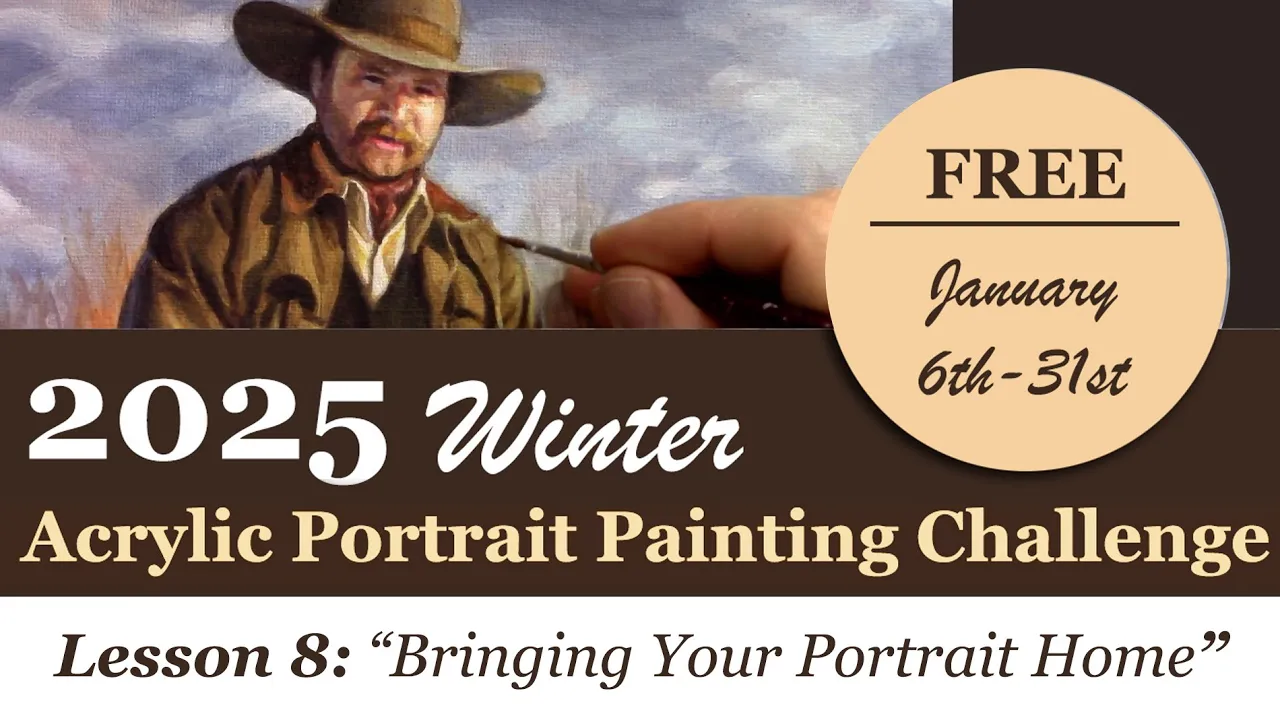
2025 Winter Acrylic Painting Challenge, Lesson 8 Bringing Your Portrait Home
Master the final touches: Bring your acrylic portrait to life with precision and confidence
Congratulations! You’ve made it to the final stage of your acrylic portrait. This is where all the hard work comes together, and your painting truly comes to life. In Lesson 8: Bringing Your Portrait Home, we will focus on refining details, sharpening edges, and adding those final highlights that make your portrait stand out.
It’s tempting to keep working indefinitely, but knowing when to stop is just as important as knowing how to start. By the end of this lesson, you’ll feel confident that your painting is complete, ready to be signed, and displayed with pride.
Step 1: Assess Your Progress
Before making any final touches, take a step back and evaluate your portrait. Ask yourself:
✔ Are the proportions and facial features balanced?
✔ Is the contrast strong enough to create depth?
✔ Do the highlights and shadows define the form effectively?
✔ Are there any unresolved areas that need attention?
If you notice anything that feels off, now is the time to make minor adjustments.
Step 2: Refining Edges and Enhancing Contrast
One of the most effective ways to bring realism to your portrait is by sharpening edges and boosting contrast.
Techniques for Crisp Edges:
- Use a small round brush with slightly thinned paint for clean, sharp lines.
- Define important areas like the jawline, nose bridge, and lips with subtle refinements.
- Blur unnecessary details in background elements to enhance depth and focus.
Boosting Contrast for Depth:
- Deepen shadows with a mix of raw umber and alizarine crimson for warmth.
- Brighten highlights using titanium white with a touch of yellow ochre for natural skin tones.
- Adjust mid-tones to create smooth transitions between light and shadow.
These small changes will make a significant difference in the overall impact of your portrait.
Step 3: Adding Final Highlights
To make your portrait pop, strategic highlights should be applied.
Where to Place Highlights:
✔ The tip of the nose and cheekbones
✔ The upper eyelids and brow ridge
✔ The edges of the lips and chin
✔ The light-catching areas of clothing or accessories
Using a dry brush technique with minimal paint can help you create soft, natural highlights without overpowering the painting.
Step 4: Knowing When to Stop
It’s easy to overwork a painting, but at some point, you must decide it’s finished. A few signs that your portrait is complete:
✔ The main subject stands out against the background.
✔ The details are refined but not overly complicated.
✔ The colors and contrast look balanced.
✔ You feel satisfied when viewing your work from a distance.
If you can check off these points, it’s time to bring your portrait home and move on to the final step—signing your artwork!
Step 5: Signing Your Painting
A signature is the finishing touch that makes your work official.
Tips for Signing Your Acrylic Painting:
✔ Use a fine brush or acrylic paint pen for precision.
✔ Place your signature in a subtle but visible area (bottom right or left corner).
✔ Keep it small and unobtrusive so it does not distract from the portrait.
✔ Use a color that complements but contrasts slightly with the background.
Once signed, your painting is officially complete!
Celebrate Your Progress!
Completing a portrait is a huge achievement! Whether you’re keeping it for yourself, gifting it, or selling it, take a moment to appreciate your hard work.
If you’ve participated in the 2025 Winter Acrylic Painting Challenge, share your final piece with the community and celebrate your growth as an artist. Remember each finished portrait is a stepping stone to even greater artistic success.
📢 Did you enjoy this challenge? Sign up for the next one and keep improving your portrait painting skills! 🎨✨
FAQs: Bringing Your Portrait Home
1. How do I know when my painting is finished?
If the details, contrast, and composition feel balanced, and you no longer see major issues, it’s time to stop. Overworking a painting can reduce its realism.
2. Should I varnish my painting after finishing?
Yes! A protective varnish will enhance colors and provide longevity. Use a gloss, satin, or matte finish, depending on your preference.
3. How can I fix mistakes in the final stages?
For minor errors, gently layer paint over the area with a dry brush. If needed, use a soft wet cloth to lift fresh paint before it dries.
4. What’s the best way to display my finished portrait?
Frame your painting with a simple, elegant border or display it on a stretched canvas for a professional look.
2025 Winter Acrylic Portrait Painting Challenge Series
2025 Winter Acrylic Portrait Painting Challenge: Steps to Get Started
2025 Winter Acrylic Portrait Challenge Pre-Lesson: Gathering Your Supplies
2025 Winter Acrylic Portrait Challenge, Lesson 1: Prepping Your Canvas for the Portrait
2025 Winter Acrylic Painting Challenge, Lesson 2: Sketching Your Portrait Accurately
2025 Winter Acrylic Painting Challenge, Lesson 3: Sealing in Your Sketch
2025 Winter Acrylic Painting Challenge, Lesson 4: Beginning Your Portrait with Glazes
2025 Winter Acrylic Painting Challenge, Lesson 5: Building Up Color and Contrast
2025 Winter Acrylic Painting Challenge,Bonus Video: Increasing Contrast
2025 Winter Acrylic Painting Challenge, Lesson 6 Shading and Color Nuances
2025 Winter Acrylic Painting Challenge, Lesson 7 Creating Realism in Your Portrait
2025 Winter Acrylic Painting Challenge, BONUS Video:Adjusting Colors and Details
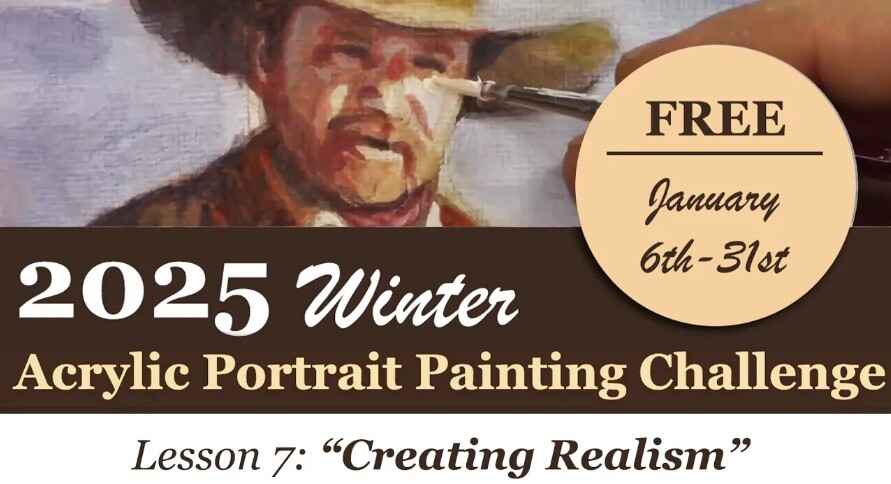
2025 Winter Acrylic Painting Challenge, Lesson 7 Creating Realism in Your Portrait
Bringing your portrait to life with realistic detail
Painting a portrait that looks lifelike requires careful attention to shading, contrast, and color blending. In this lesson of the 2025 Winter Acrylic Painting Challenge, we will focus creating realism in your portrait on refining details, adjusting highlights and shadows, and building realistic skin tones using the glazing technique. If you want to take your portrait to the next level, mastering these techniques will make all the difference.
Step-by-Step Process for Creating Realism in Your Portrait
1. Refining Facial Features with Subtle Adjustments
The face is the focal point of any portrait. In this step, we will:
- Deepen the shadows to define the contours of the face.
- Add warm highlights to create a sense of volume.
- Adjust color transitions for smoother blending.
To start, a detailed brush is used to apply a translucent glaze of raw umber dark and ultramarine blue over the shadowed areas. A touch of alizarine crimson is then added to neutralize any harshness.
2. Enhancing Skin Tones for Natural Depth
Acrylic glazing allows for gradual tone building. The following color mixes are applied in thin layers:
- Warm tones: A combination of burnt sienna, raw sienna, and napthol red is used for rich skin undertones.
- Cool tones: A glaze of ultramarine blue and titanium white is added for reflective highlights.
- Midtones: A mix of organic orange and Indian yellow is applied to balance the transitions.
Each layer is blended using a size 2 round brush to create smooth gradations, ensuring the portrait has a lifelike appearance.
3. Strengthening Contrast for Increased Realism
Realism depends on well-executed contrast. By reinforcing the darkest areas and refining highlights, the portrait gains a three-dimensional look.
- The shadows under the hat brim, on the sides of the face, and within the beard are darkened using raw umber dark mixed with matte medium.
- The reflected light from the snow is captured by adding a cooler highlight using titanium white and ultramarine blue.
Applying these techniques ensures that the light and shadows interact naturally, making the subject appear more lifelike.
Tips & Techniques for Creating Realism in Your Portrait
✅ Layer Thinly – Avoid thick applications. Multiple thin glazes create depth.
✅ Use Color Temperature Correctly – Warm tones advance, cool tones recede.
✅ Refine Gradients – Blend shadows and highlights smoothly to avoid harsh transitions.
✅ Observe Reference Photos – Study how light interacts with skin, clothing, and surrounding elements.
✅ Step Back & Assess – Viewing your painting from a distance helps spot necessary adjustments.
Bringing realism to your acrylic portrait requires patience and careful layering. By focusing on shading, contrast, and color nuances, your painting will come to life. Keep refining, keep glazing, and enjoy the process of creating a masterpiece.
👉 Join the challenge today and take your portrait painting skills to the next level!
Frequently Asked Questions (FAQ)
Q: How do I prevent my highlights from looking too harsh?
A: Use a soft brush and apply highlights in thin glazes, gradually building them up rather than adding a thick, opaque layer.
Q: What should I do if my shadows look too flat?
A: Introduce color variations within shadows by using warm and cool tones to create depth. Adding a touch of alizarine crimson or ultramarine blue can help.
Q: How can I make my portrait look less ‘painted’ and more realistic?
A: Focus on smooth transitions and subtle color shifts. Avoid sharp edges unless defining key features like the eyes or lips.
Q: Can I fix an area if I’ve applied too much color?
A: Yes! Acrylic glazing is forgiving. Apply a thin layer of titanium white mixed with matte medium to soften or correct areas.
2025 Winter Acrylic Portrait Painting Challenge Series
2025 Winter Acrylic Portrait Painting Challenge: Steps to Get Started
2025 Winter Acrylic Portrait Challenge Pre-Lesson: Gathering Your Supplies
2025 Winter Acrylic Portrait Challenge, Lesson 1: Prepping Your Canvas for the Portrait
2025 Winter Acrylic Painting Challenge, Lesson 2: Sketching Your Portrait Accurately
2025 Winter Acrylic Painting Challenge, Lesson 3: Sealing in Your Sketch
2025 Winter Acrylic Painting Challenge, Lesson 4: Beginning Your Portrait with Glazes
2025 Winter Acrylic Painting Challenge, Lesson 5: Building Up Color and Contrast
2025 Winter Acrylic Painting Challenge,Bonus Video: Increasing Contrast
2025 Winter Acrylic Painting Challenge, Lesson 6 Shading and Color Nuances
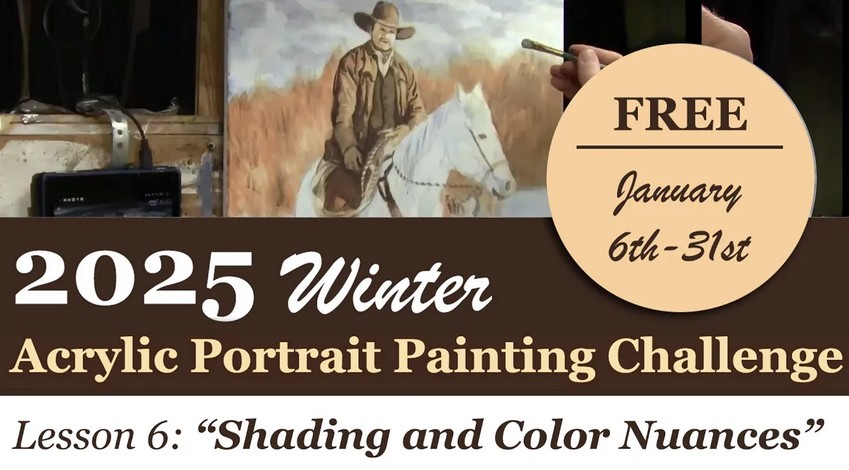
2025 Winter Acrylic Painting Challenge, Lesson 6 Shading and Color Nuances
Shading and color nuances refining depth in your portrait
In this lesson, we focus on refining shading and developing color nuances to bring more depth and realism to our acrylic portrait. By applying glazes strategically, midtones are blended seamlessly, and the transition between highlights and shadows becomes more natural. This technique helps in building the structure of the face, clothing, and background while maintaining smooth tonal gradations.
Before beginning, ensure that your palette is well-prepared. The paints should be moist, making them easier to blend. Using aluminum foil as a mixing surface can provide a fresh start without affecting previous colors.
Recommended Brushes and Materials:
- 1-inch flat brush
- 3/4-inch flat brush
- Round brush (size 5 or 6)
- Matte medium
- Aluminum foil (for palette preparation)
Step 1: Strengthening the Background Contrast
To enhance the overall contrast, the background must be adjusted. This is done by deepening the grass and reeds while subtly refining the hills in the distance.
Mixing the First Glaze:
- Raw umber dark – for depth
- Burnt sienna – to warm up the undertones
- Matte medium – for smooth application
Using a flat brush, apply this glaze in the upper left corner, gradually blending down. Light pressure should be used in some areas to maintain a sense of atmospheric perspective.
Step 2: Adjusting the Right Side with Cooler Tones
To balance out the warmth in the painting, a cooler glaze is introduced.
Mixing the Cool Glaze:
- Raw umber dark – base tone
- Ultramarine blue – cools down the mix
Apply this glaze carefully to the right side, creating a contrast with the warmer reeds on the left. This step ensures variation in color temperature, making the painting feel more dynamic.
Step 3: Developing Mid-tones in Clothing and Facial Features
Now that the background has been balanced, attention shifts to shading the portrait’s clothing and facial features.
Mixing the Midtone Glaze:
- Raw umber dark – primary base
- Burnt sienna – to warm it up
- Titanium white – to introduce opacity
- Raw sienna – softens the transition
Apply this glaze using a round brush in areas that require subtle shading. The transition between shadows and highlights should be gradual. Midtones help define the shape of the jacket, adding depth to folds and creases.
Step 4: Enhancing Contrast with Darker Glazes
To refine the shading and increase contrast, a darker glaze is applied. This helps in defining areas such as:
- The lapel and collar of the jacket
- The brim of the hat
- The creases in the vest and buttons
Mixing the Deep Contrast Glaze:
- Raw umber dark – for depth
- Ultramarine blue – enhances shadows
- Alizarine crimson – adds richness
- Titanium white – to control opacity
Using a detail brush, gently layer this glaze on darker sections, such as the folds of the jacket and the underside of the hat brim. The contrast between these darker areas and the lighter highlights enhances the three-dimensional quality of the portrait.
Step 5: Fine-Tuning Facial Shadows
Shading the face requires a delicate approach to maintain soft transitions. A semi-opaque glaze is mixed using:
- Titanium white – to soften
- Raw sienna – for a warm undertone
- Burnt sienna – adds richness
Apply this glaze to areas such as the shadowed side of the face, beneath the hat, and along the bridge of the nose. Soft strokes ensure the blending appears natural without harsh transitions.
Tips and Techniques for Better Shading and Color Nuances
✅ Use a variety of brushes – Flat brushes are ideal for larger areas, while detail brushes help refine intricate shapes.
✅ Layer gradually – Build up tones slowly rather than applying heavy pigment all at once.
✅ Balance warm and cool tones – A mix of warm browns and cool blues enhances realism.
✅ Keep glazes transparent – Overloading paint can create muddy colors and reduce depth.
✅ Blend softly – Use light pressure when transitioning between tones for a smoother effect.
Incorporating shading and color nuances is crucial for achieving depth in an acrylic portrait. By carefully layering glazes, adjusting midtones, and refining shadows, the painting develops a more lifelike quality. The next lesson will continue refining these details, ensuring the portrait reaches a polished and professional finish.
Would you like to try this technique in your next painting? Share your progress in the Realistic Acrylic Portraits Facebook Group and join fellow artists in the 2025 Winter Acrylic Painting Challenge!
🔹 Join the challenge today: RealisticAcrylic.com
Frequently Asked Questions (FAQs)
1. Why is shading and color nuance important in portrait painting?
Shading creates depth, while color nuances ensure natural transitions between highlights and shadows, making the portrait look more realistic.
2. How do I avoid a chalky appearance when adding highlights?
Mix titanium white with raw sienna or burnt sienna to balance opacity and warmth. Applying too much white alone can make highlights look unnatural.
3. What is the best way to control glaze transparency?
Using matte medium ensures that glazes remain translucent. Adjust the paint-to-medium ratio depending on how strong or subtle you want the effect.
4. How many layers of glazing should be applied?
Multiple thin layers should be applied rather than a single thick one. This method allows for better control over color depth and smooth transitions.
5. Can I use a hairdryer to speed up drying between layers?
Yes, but use a low heat setting to avoid cracking or warping the paint.
2025 Winter Acrylic Portrait Painting Challenge Series
2025 Winter Acrylic Portrait Painting Challenge: Steps to Get Started
2025 Winter Acrylic Portrait Challenge Pre-Lesson: Gathering Your Supplies
2025 Winter Acrylic Portrait Challenge, Lesson 1: Prepping Your Canvas for the Portrait
2025 Winter Acrylic Painting Challenge, Lesson 2: Sketching Your Portrait Accurately
2025 Winter Acrylic Painting Challenge, Lesson 3: Sealing in Your Sketch
2025 Winter Acrylic Painting Challenge, Lesson 4: Beginning Your Portrait with Glazes
2025 Winter Acrylic Painting Challenge, Lesson 5: Building Up Color and Contrast
2025 Winter Acrylic Painting Challenge,Bonus Video: Increasing Contrast

2025 Winter Acrylic Painting Challenge,Bonus Video: Increasing Contrast
Master the art of increasing contrast in your acrylic portraits with simple glazing techniques
In this bonus session of the 2025 Winter Acrylic Painting Challenge, we focus on an essential stepincreasing contrast to create more depth and realism. By building up layers and refining shadows, we can bring out key elements in the portrait before moving into the next lesson.
Why Contrast Matters in Acrylic Painting
Contrast is one of the fundamental principles that makes a painting stand out. It helps define the subject, create a sense of depth, and guide the viewer’s eye. Without proper contrast, an image may appear flat or lifeless.
In this lesson, the focus is on:
- Strengthening shadows and highlights
- Refining shapes with precise brushwork
- Using glazing techniques for smooth transitions
Materials Used
- Raw Umber Dark
- Ultramarine Blue
- Alizarine Crimson
- Titanium White
- Raw Sienna
- Matte Medium
- Round Detail Brush (Size 2)
- Flat Brush (1/4 inch)
Step-by-Step Process for Increasing Contrast
1. Adding Definition to Clothing and Accessories
The first area of focus is the clothing, particularly the buttons and fabric folds. To prevent losing the details, a light mixture of titanium white and raw sienna is applied to the buttons. This ensures they remain visible even after additional layers of paint are added.
- Mix titanium white with raw sienna for an opaque highlight.
- Apply it in thin, controlled strokes to emphasize the button edges.
- Allow the layer to dry before applying additional glazes.
2. Applying a Glaze for Deeper Shadows
To create a darker value for the clothing shadows, a glaze is prepared using raw umber dark, ultramarine blue, and a touch of alizarine crimson mixed with matte medium.
- This mixture is semi-translucent, allowing previous layers to remain visible.
- It is applied to the edges of the clothing and negative spaces between elements.
- A smooth gradient is achieved by feathering out the edges with a dry brush.
3. Refining Shadows in Facial Features
To make the face more three-dimensional, subtle shadows are introduced under the hat brim, around the eyes, and along the mustache and beard.
- A smaller detail brush is used for precision.
- A glaze mixture similar to the clothing shadows is applied in thin layers.
- The darkest areas are carefully deepened while still allowing for soft transitions.
4. Enhancing the Background and Rope Details
The negative space behind the subject is darkened to make the foreground stand out. Additionally, the ropes and scarf details are defined by using precise brush strokes.
- A darker glaze is applied to the background while maintaining soft edges.
- The spaces between the ropes are carefully shaded to enhance contrast.
- Layering shadows on the scarf creates a sense of texture and folds.
Tips for Mastering Contrast in Acrylic Painting
✔ Use a Limited Palette for Shadows: Mixing complementary colors rather than using straight black results in more natural-looking shadows.
✔ Work from General to Specific: Begin with broad shadow areas before refining small details.
✔ Layer Gradually: Instead of applying dark paint all at once, build it up in thin layers to control the intensity.
✔ Utilize Soft and Hard Edges: Hard edges emphasize details, while soft edges create depth and natural transitions.
✔ Check Your Painting in Black and White: Viewing your work in grayscale helps assess contrast levels effectively.
By following these steps and gradually increasing contrast, your painting will gain a greater sense of realism. Whether you are working on clothing, facial features, or background elements, strategic contrast adjustments can make all the difference.
Keep practicing, and don’t be afraid to layer and refine your shadows! What part of contrast enhancement do you find most challenging? Let’s discuss in the comments below.
🚀 Stay tuned for the next lesson in the 2025 Winter Acrylic Painting Challenge! Don’t forget to join my Facebook group, where I post update for the next lessons.
Frequently Asked Questions: Increasing Contrast in Acrylic Painting
Q: Why does my painting still look flat even after adding shadows?
A: The issue might be the lack of balance between shadows and highlights. Try increasing contrast in both areas by brightening highlights and deepening shadows gradually.
Q: How many layers should I use for proper contrast?
A: This depends on the opacity of your paint. Glazing techniques require multiple thin layers, while more opaque applications may need fewer.
Q: How can I blend shadows smoothly in acrylic painting?
A: Using matte medium or water can help create smoother transitions. Also, working while the paint is still wet allows for better blending.
2025 Winter Acrylic Portrait Painting Challenge Series
2025 Winter Acrylic Portrait Painting Challenge: Steps to Get Started
2025 Winter Acrylic Portrait Challenge Pre-Lesson: Gathering Your Supplies
2025 Winter Acrylic Portrait Challenge, Lesson 1: Prepping Your Canvas for the Portrait
2025 Winter Acrylic Painting Challenge, Lesson 2: Sketching Your Portrait Accurately
2025 Winter Acrylic Painting Challenge, Lesson 3: Sealing in Your Sketch
2025 Winter Acrylic Painting Challenge, Lesson 4: Beginning Your Portrait with Glazes
2025 Winter Acrylic Painting Challenge, Lesson 5: Building Up Color and Contrast
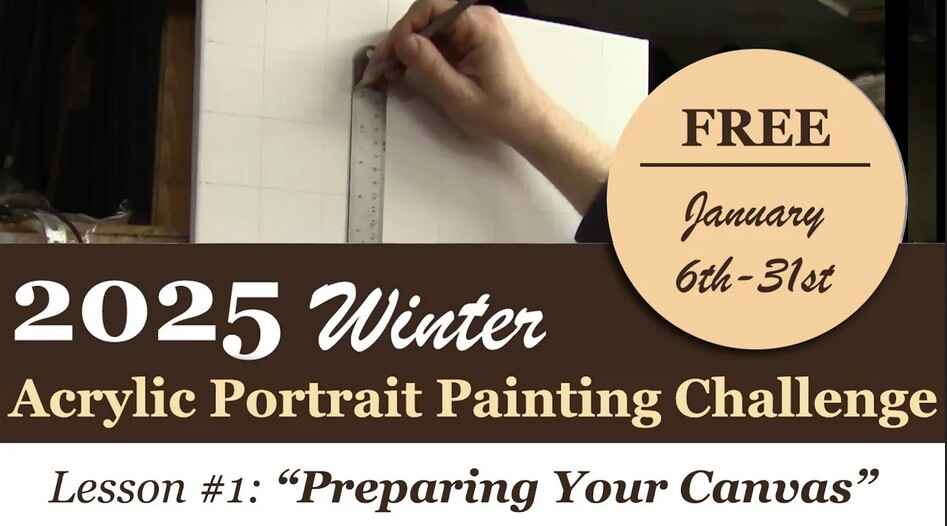
2025 Winter Acrylic Portrait Challenge, Lesson 1: Prepping Your Canvas for the Portrait
Master the art of prepping your canvas for a smooth and successful portrait painting
In this first lesson of our Winter Acrylic Portrait Challenge Masterclass, we will dive into the crucial process of prepping your canvas for the portrait. Whether you are a seasoned artist or a beginner, taking the time to properly prepare your canvas for the portrait that will ensure that your painting has a solid foundation for detailed and lifelike results.
Step 1: Setting Up Your Canvas
Before diving into the painting process, it is important to ensure that your canvas is in good shape. Start by setting up your canvas firmly on the easel. In our challenge, we are using a 16×20 canvas, which is a great size for portraits. When setting up your canvas, always check the square corners with a square tool or simply by eye. You should also inspect the canvas from the side to make sure it’s not bowed or distorted.
If you notice any bumps or dents, don’t worry this is a common issue, especially if your canvas has been stored for a while. These minor imperfections can be easily corrected.
Step 2: Fixing Wrinkles and Dents
Sometimes, after a canvas is unwrapped from its packaging, wrinkles or dents can appear. A simple solution for this is to lightly mist the back of your canvas with water. Use a spray bottle or mister to ensure that the entire back is saturated, especially in the corners. After spraying, let the canvas dry completely either by hanging it up or allowing it to air dry. This step is crucial because it tightens the fabric and eliminates any imperfections, leaving you with a taut and smooth canvas that will be perfect for painting.
Step 3: Applying Gesso for a Smooth Surface
Now, let’s move on to the critical step of applying gesso. Even though most canvases come pre-primed, the primer they use is often too thin to create a smooth and rigid surface. By applying gesso, you add a thicker coat that not only improves the rigidity of your canvas but also provides a smoother texture ideal for detailed painting.
Gesso also makes your canvas more archival, ensuring that your artwork will stand the test of time. For this lesson, we will be applying a custom mix of gesso and matte medium. To start, pour the gesso into a small container. You will need a condiment container or small disposable cup for this task. Add about 50% gesso and 50% matte medium. The matte medium will help to thin the gesso, allowing it to be applied more smoothly while also ensuring that the surface is perfect for sketching.
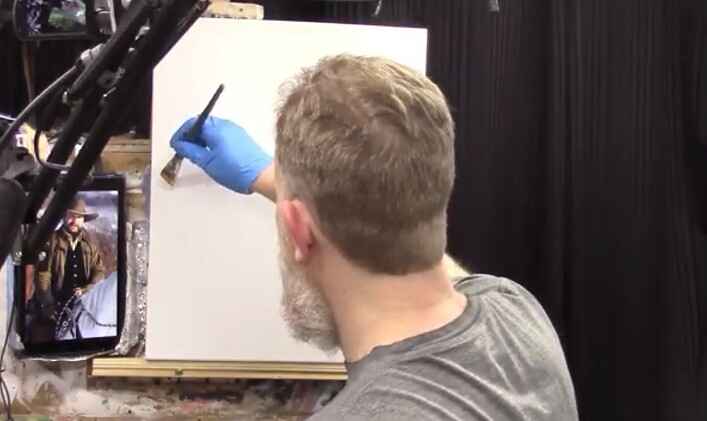
Step 4: Stirring the Mixture
Once you have your gesso and matte medium in your container, stir the mixture thoroughly with an old brush or a stirring stick. The goal is to ensure that the two components blend together to form a smooth and consistent mixture. A 50/50 ratio works well, but feel free to adjust depending on the desired consistency. The matte medium will not only improve the application of the gesso but also create an ideal surface for sketching, allowing your colored pencils to adhere better.
Step 5: Applying the Gesso Mixture
Now it’s time to apply the gesso mixture to your canvas. Using a brush, evenly coat the surface with the gesso. Work in smooth, gentle strokes to cover the entire canvas. You should aim for an even layer that is not too thick or thin. Be sure to cover the edges of the canvas as well. Once applied, allow the gesso to dry completely before proceeding to the next steps of your painting process.
Properly prepping your canvas is a fundamental step in achieving a high-quality portrait painting. With the right techniques, such as checking for squareness, fixing wrinkles, and applying a smooth gesso layer, you are setting yourself up for success. By following these steps, you can ensure that your painting will have a strong foundation for detailed and accurate portrait work.
In this first lesson, we have set the stage for an exciting and rewarding painting experience. As you progress through this Winter Acrylic Portrait Challenge, continue to refer back to these preparation steps for each new portrait you tackle. With every layer and brushstroke, your painting will come to life, and you’ll be proud of the portrait you’ve created. Keep practicing, and don’t hesitate to ask for support from the community together, we can achieve beautiful portraits!
By prepping your canvas properly, you are taking the first step toward a successful portrait painting. Join us for the full Winter Acrylic Portrait Challenge and start creating the portrait of your dreams today! Pre-Lesson: Gathering Supplies
To know more watch my video tutorial below.
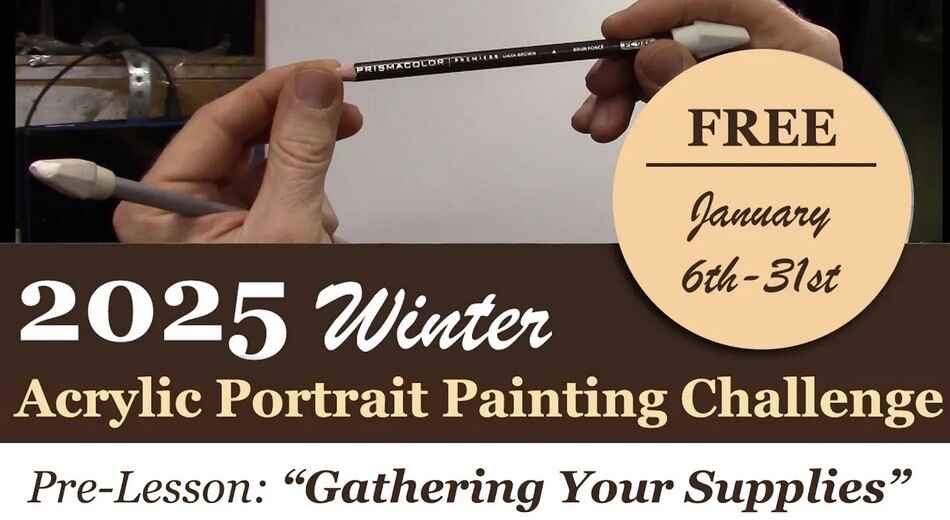
2025 Winter Acrylic Portrait Challenge Pre-Lesson: Gathering Your Supplies
Master the art of acrylic portraits: Start with the right supplies for the winter challenge
Welcome to the Challenge
The Winter Acrylic Portrait Challenge Masterclass is here, and this pre-lesson sets the stage for a transformative artistic journey. Whether you’re a seasoned painter or new to acrylics, this challenge will help you develop your skills and create a stunning winter portrait. Let’s dive into the essential supplies and steps to ensure your success.
What Makes This Challenge Special?
This is the first-ever Winter Acrylic Portrait Challenge, a unique opportunity to explore the beauty of acrylic portraiture in a winter theme. Past challenges have inspired thousands of artists to push their boundaries, with many creating portraits for the first time. This challenge builds on that success, offering you a step-by-step guide and a supportive community.
Why Should You Join?
If you haven’t signed up yet, now is the time! Joining the challenge grants you access to:
- A Welcome Kit: A detailed guide with everything you need to participate.
- Step-by-Step Lessons: Video tutorials that simplify complex techniques.
- Supportive Community: Engage with fellow artists, share progress, and seek guidance.
Sign up today ➡️ https://realisticacrylic.com/acrylic-portrait-painting-challenge/
Supplies You’ll Need
Gathering the right materials is the first step. Here’s a checklist to get you started:
- Acrylic Paints: A basic set including primary colors, white, black, and earth tones.
- Brushes: A variety of sizes, including round, flat, and detail brushes.
- Canvas or Hardboard: A primed surface for your artwork.
- Palette: Preferably with wells to keep colors clean and organized.
- Reference Photo: Included in the welcome kit – a horse and rider in the snow.
- Other Essentials: A water container, paper towels, and a palette knife.
The welcome kit also provides a palette layout guide, ensuring your colors stay vibrant and unmuddied during mixing.
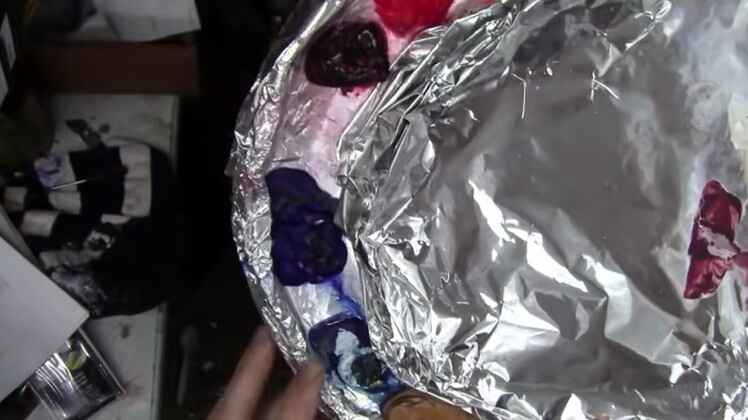
The Power of Community
Participating in this challenge means joining a community of like-minded artists. Share your progress on social media or the exclusive Facebook group, where you’ll receive feedback, encouragement, and tips to overcome challenges.
The Importance of Faith in Art
Throughout the challenge, you’ll be reminded that creativity is a gift. Trust in your abilities and the guidance provided. With persistence, support, and faith, you can create a portrait to be proud of.
Step-by-Step Guidance for Success
The masterclass lessons will guide you through:
- Sketching your portrait using grids for accuracy.
- Layering and blending techniques for depth and realism.
- Overcoming common struggles with acrylics.
If you feel stuck, reach out to the community or re-watch the tutorials for clarity.
A Final Word of Encouragement
The Winter Acrylic Portrait Challenge is more than a painting class; it’s an opportunity to grow, connect, and inspire others with your art. Whether this is your first portrait or your tenth, you’ll finish the challenge with newfound confidence and skills.
Take the First Step
Don’t let hesitation hold you back. Gather your supplies, sign up, and embark on this incredible artistic journey. You’ll be amazed at what you can achieve.
Let’s paint something extraordinary together
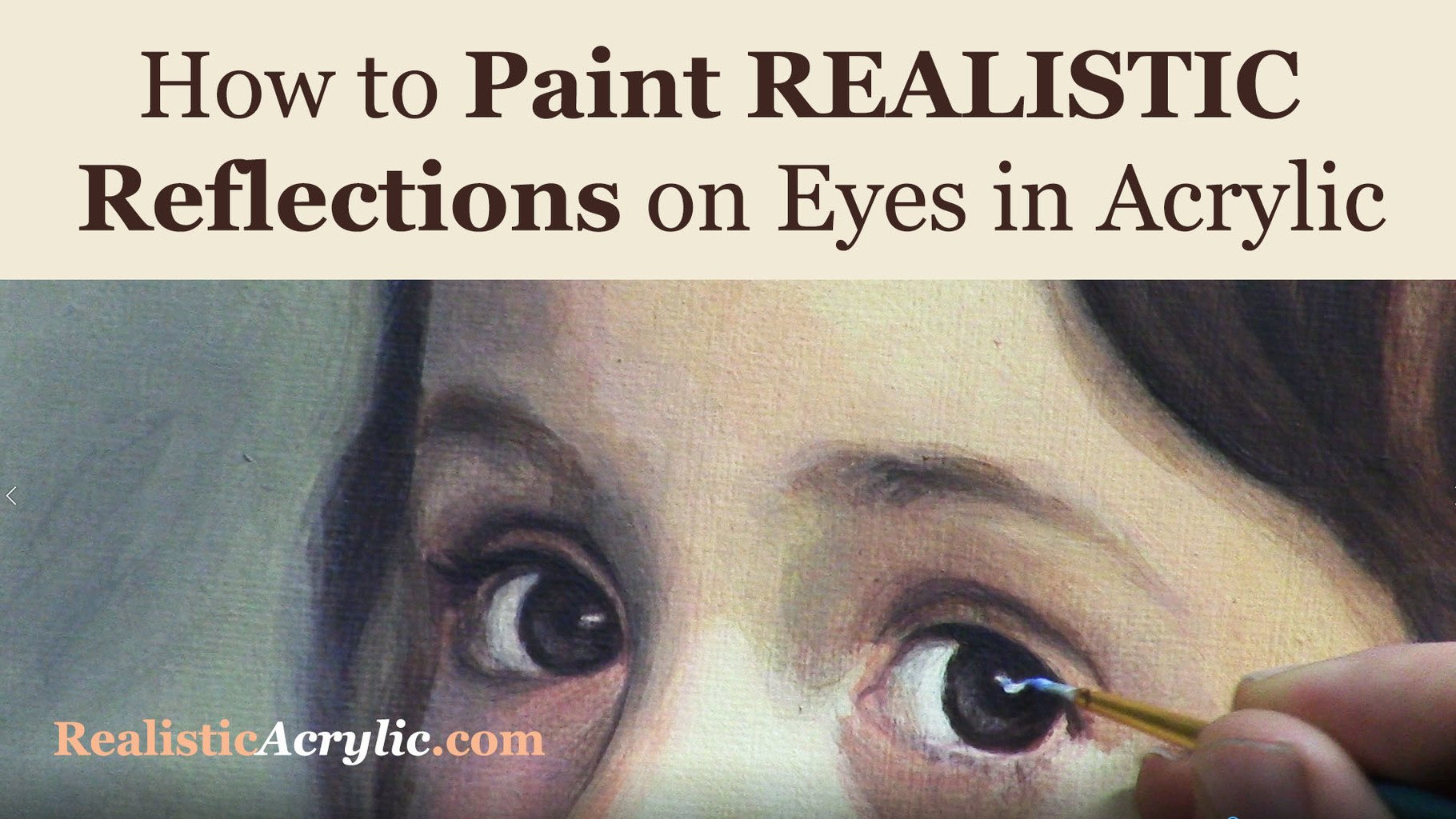
How to Paint Realistic Reflections on Eyes in Your Acrylic Portrait
Eyes are the most important feature of an acrylic portrait. When you paint the eyes correctly, everything else seems to fall into place so much easier.
In this video, I’ll show you how to paint realistic reflections, using two complementary colors in addition to white, and getting the shape of the reflection just right. Then this originally was a BONUS video in the Acrylic Portrait Painting Challenge Master Class, now available in the All-Access Membership at Realistic Acrylic Portrait School.
Even though it is technically over, you can take the Acrylic Portrait Painting Challenge (it’s FREE!) and paint along with us! 8 master class lessons are posted to help you paint a portrait you can be proud of!
REGISTER TODAY. The challenge is ongoing, something you can do at your own pace. It’s not too late to enter! After you join, I’ll send you the supplies list and reference photos to paint from.
Register for the Challenge!WATCH NOW…
Lesson #8: How to Paint Realistic Reflections on Eyes in Acrylic
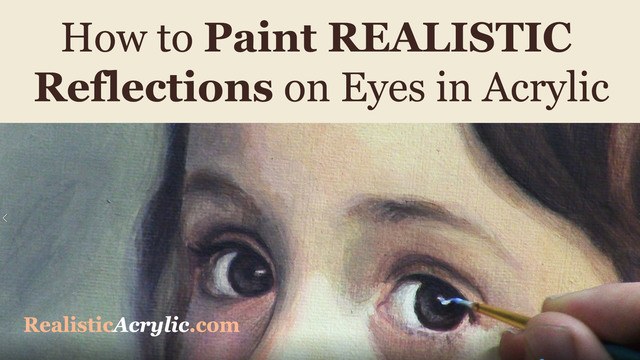
Questions? Suggestions? Thoughts? Let me know, below in the comments. Please share your sketches in our Facebook group and share this post with your friends!
- How to Paint Foliage Using the Acrylic Glazing Technique
- How to Trace for an Accurate Portrait Sketch
- How to Paint Realistic Eyes in Your Acrylic Portrait
- How to Add Raw Umber Dark & Ultramarine Blue to Your Portrait
- How to Make Your Own Raw Umber Dark
- How to Paint Realistic Trees & Grass in Your Acrylic
- How to Block In Skin Tone Values Using Glazing Technique
- How to Paint Vibrant Reds in Your Acrylic Portrait
- How to Glaze Background Colors & More Acrylic Portrait
- How to Paint White Clothing in Your Acrylic Portrait
- How to Easily Transition from a Sketch to a Painting
- How to Block In Shading & Skin Tones in Your Acrylic
- How to Build Up Color on Acrylic Pet Portrait
- How to Build Up Form on Clothing with Acrylic
- How to Paint Dark Clothing Using Acrylic Glazing Technique
- How to Paint a 24 x 30 Acrylic With 30 People
- How to Do Smooth Shading with Acrylic
- How to Sketch an Acrylic Portrait with a Grid
Read more about how to paint a portrait that you can surely be proud of!
I’d love to hear your thoughts about this video. Please share it with your friends and family. Let me know if you have any further questions. I’ll greatly help you.
Thank you so much for taking the time to read this tutorial and watch the video. That means a lot to me. I hope you find it very helpful in your portrait painting.

P.S. Did you find this post helpful or encouraging? If so, send it on ahead! Let others know with the share buttons below. I’d love to hear your comments. Thank you so much! Also, do you have a question on acrylic portrait painting you’d like answered? Let me know, and I’d be happy to help!
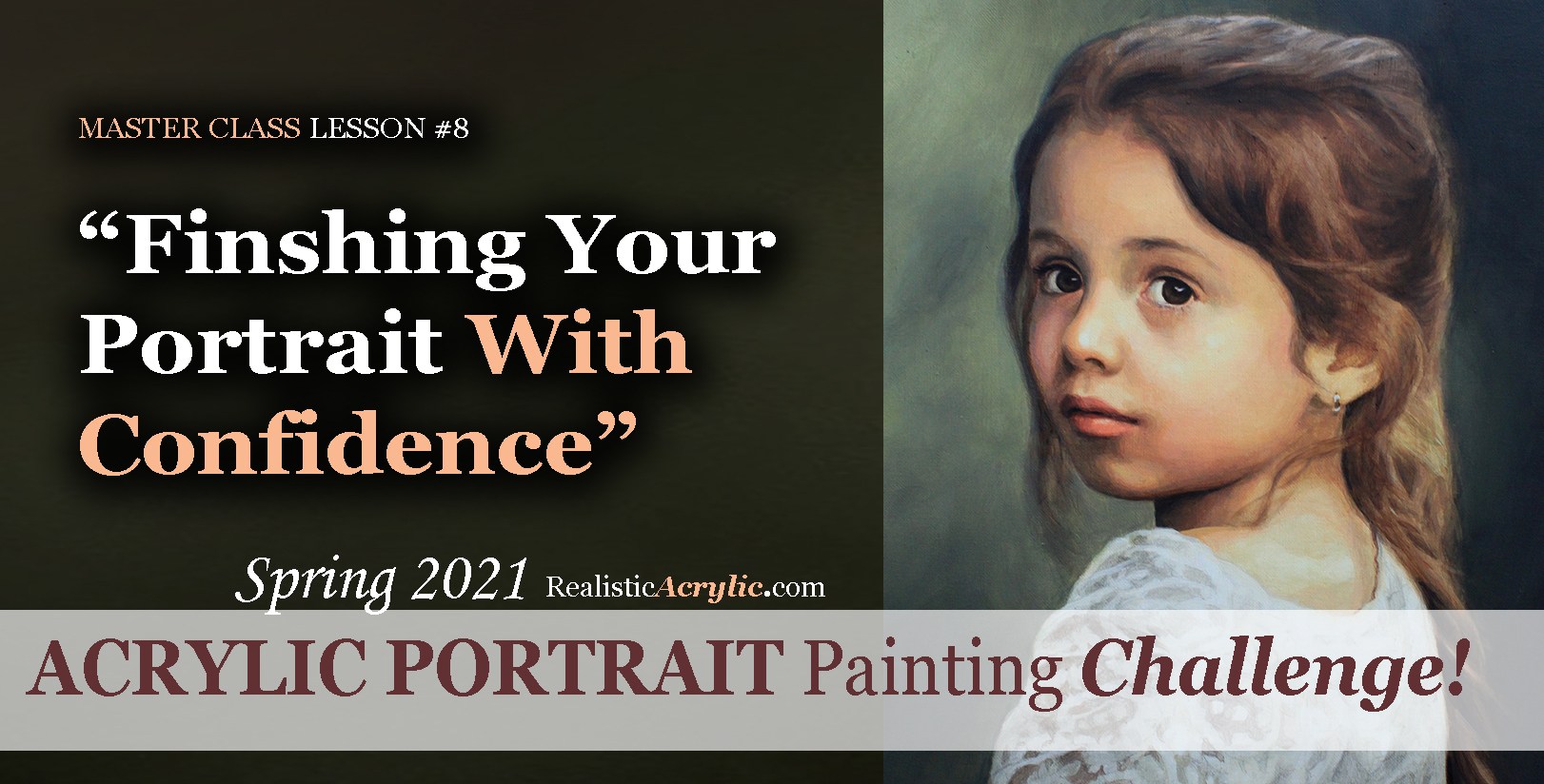
Spring 2021 Acrylic Portrait Painting Challenge: Finishing Your Portrait With Confidence
Let’s help you finish your painting!
In this lesson, we will be wrapping up the Masterclass series for the challenge! I’ll show you how to add some more nuances and details to the portrait of “Cora.” First, we’ll add a glaze to her hair to enrich the overall color. Next, we will enhance some nuances on her eyebrows, dial in the color of the eyes, and paint in the reflections. Finally, we’ll add in the skin tone for her arm in the lower corner and follow up with some work on her lace.
But even though we are nearly done with this portrait painting, it’s not too late to join in the fun!
YOU, too, can paint a portrait!
Take the Acrylic Portrait Painting Challenge (it’s FREE!) and paint along with us!
REGISTER TODAY. The challenge is ongoing, something you can do at your own pace. It’s not too late to enter! After you join, I’ll send you the supplies list and reference photos to paint from.
WATCH NOW…
Lesson #8: Finishing Your Portrait Confidently
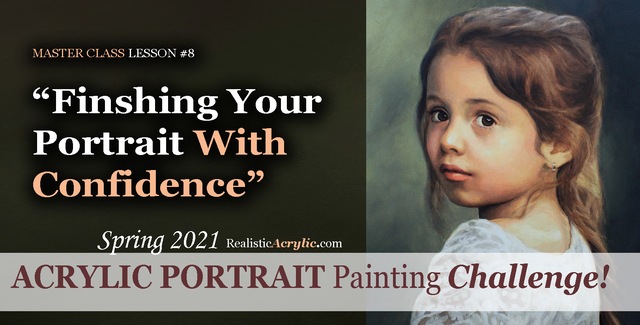
Professional artist and instructor Matt Philleo will teach you how to paint an acrylic portrait you can be proud of with this Portrait Painting Challenge!
Would like to paint this portrait with me and hundreds of other artists?
Take the 2021 Spring Portrait Painting Challenge!
You can register below and get started. It is completely FREE to join the challenge and participate. When you join, I’ll send you the “Welcome Kit” which includes:
- The Supplies List (so you know what you need to paint with us, your shopping list. 🙂 )
- The Reference Photo with and without the grid, high resolution, that you can download ready to print out or display on your tablet. You’ll be able to create an accurate portrait this way.
- The Palette Layout Guide showing you how to arrange your colors so they don’t get muddy on your palette
- The Master Class Lesson Schedule
- the Lessons emailed to you
- A private Facebook group to cheer you and help answer your questions
- And a few “bonuses” like opportunities to win my paid online classes
REGISTER TODAY. The challenge is ongoing, something you can do at your own pace. It’s not too late to enter!
Let me know if you have any questions and I look forward to teaching you more!
—Matt
Questions? Suggestions? Thoughts? Let me know, below in the comments. Please share your sketches in our Facebook group and share this post with your friends!
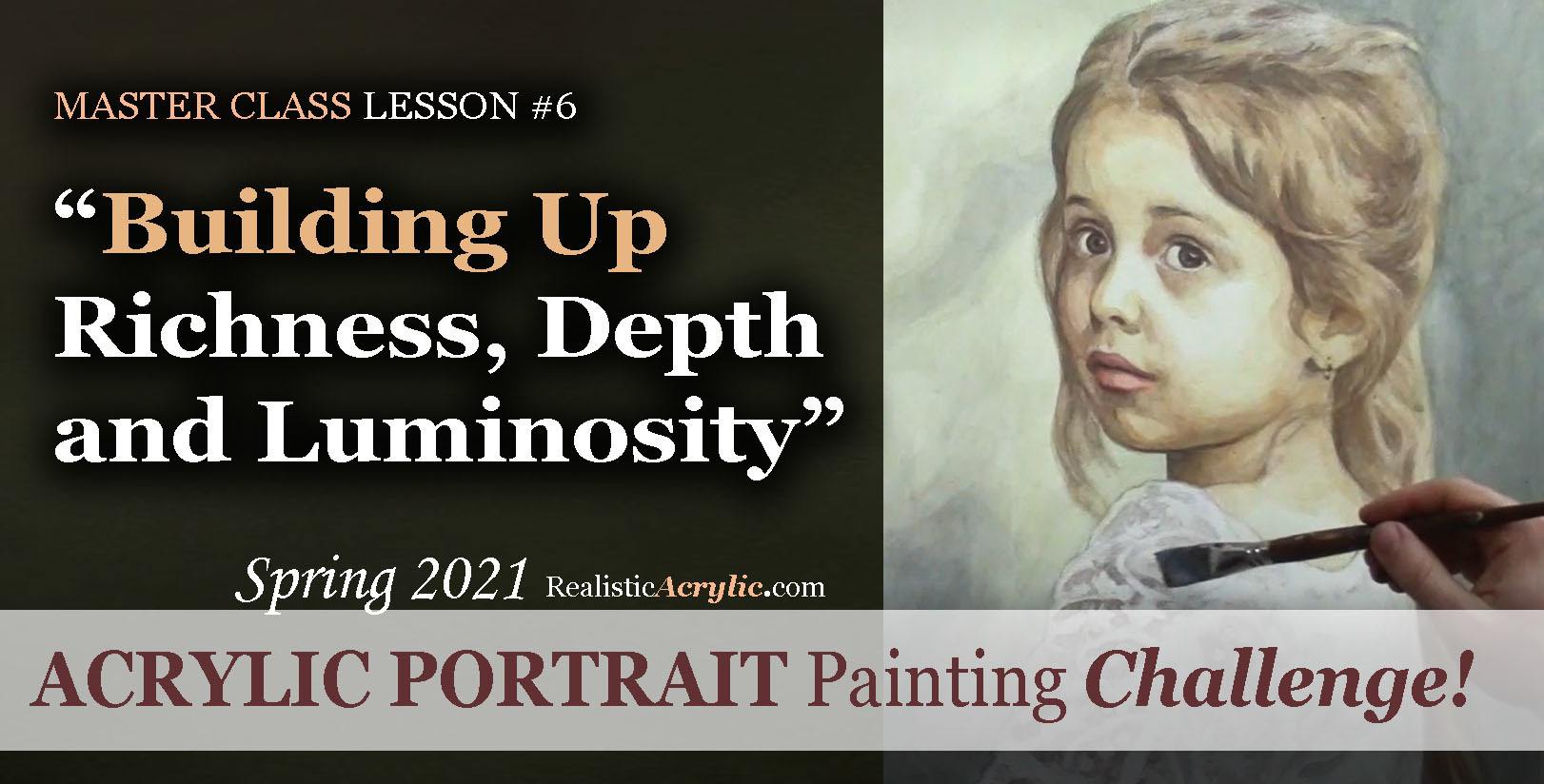
Spring 2021 Acrylic Portrait Painting Challenge: Painting Delicate Details and Nuances
After building the foundation with several layers of value, form, and color, we can then start to “dial in” the detail and nuances.
In this master class lesson (7 of 8), I’ll demonstrate how to add specific detail shapes to “Cora’s” hair. I’ll also add some additional shading to her forehead with a very translucent glaze. Next, I darken the left side of her face while smoothing out some of the rough application of previous glazes with a semi-opaque layer that’s cooler in tone. Finally, I add nuances to her eyes, lips and chin.
But even though we are well along in this portrait painting, it’s not too late to join in the fun!
YOU, too, can paint a portrait!
Take the Acrylic Portrait Painting Challenge (it’s FREE!) and paint along with us!
REGISTER TODAY. The challenge is ongoing, something you can do at your own pace. It’s not too late to enter! After you join, I’ll send you the supplies list and reference photos to paint from.
WATCH NOW…
Lesson #7: Painting Delicate Details and Nuances
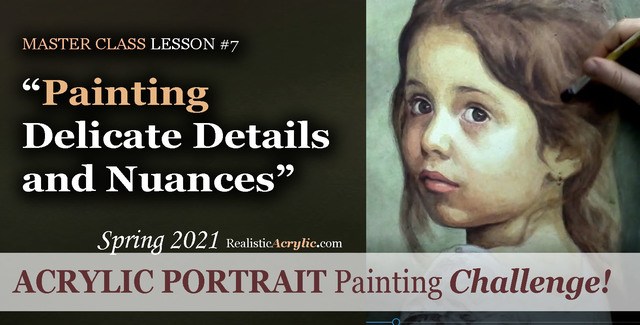
Learn how to do smooth shading, skin tones, details, and nuances in this FREE online portrait painting class by Matt Philleo at Realistic Acrylic Portrait School
Would like to paint this portrait with me and hundreds of other artists?
Take the 2021 Spring Portrait Painting Challenge!
You can register below and get started. It is completely FREE to join the challenge and participate. When you join, I’ll send you the “Welcome Kit” which includes:
- The Supplies List (so you know what you need to paint with us, your shopping list. 🙂 )
- The Reference Photo with and without the grid, high resolution, that you can download ready to print out or display on your tablet. You’ll be able to create an accurate portrait this way.
- The Palette Layout Guide showing you how to arrange your colors so they don’t get muddy on your palette
- The Master Class Lesson Schedule
- the Lessons emailed to you
- A private Facebook group to cheer you and help answer your questions
- And a few “bonuses” like opportunities to win my paid online classes
REGISTER TODAY. The challenge is ongoing, something you can do at your own pace. It’s not too late to enter!
Let me know if you have any questions and I look forward to teaching you more!
—Matt
Questions? Suggestions? Thoughts? Let me know, below in the comments. Please share your sketches in our Facebook group and share this post with your friends!

Spring 2021 Acrylic Portrait Painting Challenge: Building Up Richness, Depth and Luminosity
Acrylic is a fantastic medium for portrait painting, but it can be so challenging to use! That is why I am teaching you the glazing technique to open a lot of possibilities and ease your frustration.
Historically, the Old Masters used small amounts of pigment dispersed in larger amounts of linseed oil or mineral spirits to create a sense of volume and depth in their paintings. Light shines through and you can see a bit of each layer beneath the ones on top.
We can use that technique to our advantage with acrylic. By applying several translucent layers, there is an increased sense of depth, shading, contrast and color saturation and luminosity.
In this particular lesson, I’ll demonstrate how to add richness to the mid-tones of the girl’s face and hair. We will also add more contrast to the image with a couple of layers to the background, and turn the form of her figure with a precisely placed glaze on her clothing.
But even though we are well along in this portrait painting, it’s not too late to join in the fun!
Take the Acrylic Portrait Painting Challenge (it’s FREE!) and paint along with us!
REGISTER TODAY. The challenge is ongoing, something you can do at your own pace. It’s not too late to enter! After you join, I’ll send you the supplies list and reference photos to paint from.
WATCH NOW…
Lesson #6: Building Up Richness, Depth, and Luminosity
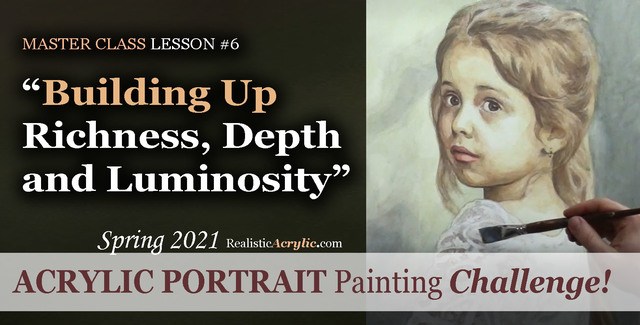
Learn how to create a vibrant acrylic portrait where the colors are not flat or muddy. In this FREE step by step master class, I’ll show you how!
Would like to paint this portrait with me and hundreds of other artists?
Take the 2021 Spring Portrait Painting Challenge!
You can register below and get started. It is completely FREE to join the challenge and participate. When you join, I’ll send you the “Welcome Kit” which includes:
- The Supplies List (so you know what you need to paint with us, your shopping list. 🙂 )
- The Reference Photo with and without the grid, high resolution, that you can download ready to print out or display on your tablet. You’ll be able to create an accurate portrait this way.
- The Palette Layout Guide showing you how to arrange your colors so they don’t get muddy on your palette
- The Master Class Lesson Schedule
- the Lessons emailed to you
- A private Facebook group to cheer you and help answer your questions
- And a few “bonuses” like opportunities to win my paid online classes
REGISTER TODAY. The challenge is ongoing, something you can do at your own pace. It’s not too late to enter!
Let me know if you have any questions and I look forward to teaching you more!
—Matt
Questions? Suggestions? Thoughts? Let me know, below in the comments. Please share your sketches in our Facebook group and share this post with your friends!
